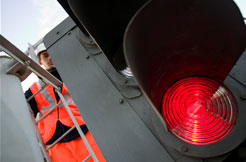New innovative approach to powering signals reduces costs and the amount of copper used
Posted: 10 October 2012 | | No comments yet
Network Rail have developed a signalling power distribution system…


After three years of planning and development, Network Rail have developed a signalling power distribution system which is lighter than that used previously and will reduce transport and laying costs, as well as the cost of the cable itself.


A complete redesign
Network Rail have redesigned the whole system of power transmission, from the transformers to the switchgear.
Normal 3-core cable has steel strands wound through it to protect it from rodent damage and other hazards – which also means that any fault will find its way to all the equipment it connects. Network Rail have developed a new form of armour, along with double or reinforced insulation for signal housing and switchgear.
Helping reduce cable theft
Network Rail’s engineers were also able to integrate identification features within the cable to allow it to be uniquely identified which hopefully will help deter cable thieves.
Reducing costs, and our environmental footprint
A project to renew 650volt signalling feeder cables in Scotland would use 267km of copper cores using traditional class 1 distribution equipment – Network Rail’s new system uses just 89 km of power cable, saving of 72 tonnes of copper at £5,000 per tonne.
Technical director Steve Yianni said: “Some signal projects use up to 200 tonnes of copper just in the cables, so we knew that if we could find a way of reducing that, then we could cut costs significantly, and reduce our environmental footprint.
“Using a class 2 signalling power system had always been thought of as impossible, or at least very difficult, but we proved it could be done. We’ve shown that if an engineer has a good idea, they will stand by it and deliver it too.”
Encouraging innovation
The work done to drive the project encouraged our suppliers – 12 different companies in this instance – to innovate and develop new technologies. In fact, those technologies could find outlets in other fields, such as double-insulated streetlamps and even switchgear for electric car chargers.
Fact file
- Class 2 cable is a generic term for enhanced unarmoured cable which provides enhanced mechanical protection, rodent protection via special fibre weave, and security protection
- The typical cost of 3-core 95mm cable is £20.68 per metre , whereas the typical cost of our new enhanced unarmoured 95mm cable is £14.13 per metre
- We also developed a polycarbonate and coating solution to insulate associated equipment, such as switchgear, transformers and signal housings
Read more about how we’re combatting cable theft, and how you can tell us about your innovative ideas.



